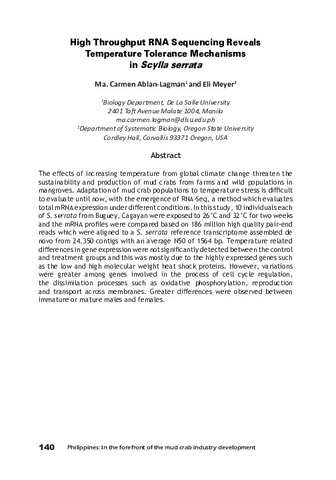Milkfish (Chanos chanos) growth hormone cDNA cloning and mRNA expression in embryos and early larval stages.
- Global styles
- MLA
- Vancouver
- Elsevier - Harvard
- APA
- Help

View/
Date
2002Author
Page views
2,041ASFA keyword
AGROVOC keyword
Taxonomic term
Metadata
Show full item record
Share
Abstract
In an attempt to understand growth regulation in milkfish, the milkfish growth hormone (GH) and its cDNA were characterized and the expression of GH mRNA in embryos and larvae was examined by RT-PCR. The milkfish GH was purified from an alkaline extract of the pituitary by reverse-phase high-performance liquid chromatography and detected as an immuno-positive protein with anti-salmon GH serum. The complete sequence of milkfish pre-GH was determined by cDNA cloning and nucleotide sequencing. On the basis of the N-terminal amino acid analysis of the native protein, the pre-GH was found to consist of a signal peptide of 22 amino acids and a mature protein of 188 amino acids. Milkfish GH shows higher amino acid sequence identity with GHs of carps (91–94%) and salmonids (70%) than with GHs of more advanced teleosts (<60%) in good accordance with its taxonomic position in teleosts. It has five half Cys residues, four of which are at positions homologous with those of other known GHs and the extra Cys with those of carp GHs. The molecular weight of milkfish GH was estimated to be 22 kDa, which is comparable to the theoretical value. This suggests that milkfish GH is a simple protein, although it has two potential N-glycosylation sites. Semiquantitative RT-PCR showed that GH mRNA expression was relatively weak in embryos and newly hatched larvae but was already strong in 2-day old and older larvae.
Suggested Citation
de Jesus, E. G. T., Ayson, F. G., Amemiya, Y., Moriyama, S., Hyodo, S., Hirano, T., & Kawauchi, H. (2002). Milkfish (Chanos chanos) growth hormone cDNA cloning and mRNA expression in embryos and early larval stages. Aquaculture , 208(1-2), 177-188. https://doi.org/10.1016/S0044-8486(01)00759-1
Type
ArticleISSN
0044-8486Collections
- Journal Articles [1258]
Related items
Showing items related by title, author, creator and subject.
-
Differential expression of insulin-like growth factor I and II mRNAs during embryogenesis and early larval development in rabbitfish, Siganus guttatus
Ayson, Felix G.; de Jesus, Evelyn Grace T.; Moriyama, Shunsuke; Hyodo, Susumu; Funkenstein, Bruria; Gertler, Arieh; Kawauchi, Hiroshi (Academic Press, 2002)In rodents, the expression of insulin-like growth factor II (IGF-II) is higher than that of insulin-like growth factor I (IGF-I) during fetal life while the reverse is true after birth. We wanted to examine whether this ... -
Daily expression patterns for mRNAs of GH, PRL, SL, IGF-I and IGF-II in juvenile rabbitfish, Siganus guttatus, during 24-h light and dark cycles
Ayson, Felix G.; Takemura, Akihiro (Elsevier, 2006)Most animals respond to changes in the external environment in a rhythmic fashion. In teleost fishes, daily rhythms are observed in plasma concentrations of some hormones but it is not clear whether these rhythms are ... -
High throughput RNA sequencing reveals temperature tolerance mechanisms in Scylla serrata
Ablan-Lagman, Ma. Carmen; Meyer, Eli (Aquaculture Department, Southeast Asian Fisheries Development Center, 2017)The effects of increasing temperature from global climate change threaten the sustainability and production of mud crabs from farms and wild populations in mangroves. Adaptation of mud crab populations to temperature stress ...





